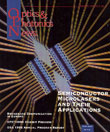
February 1993 Issue
Feature Articles
Broadband Communication in Europe
This paper sketches telecommunication developments in the European Community over the past 10 years, and traces the influence of the RACE Program (Research into Advanced Communication Technologies for Europe).
by T. J. B. SwanenburgPhotoCD: Music for Your Eyes, Part 1
The marriage of a digital data distribution product and conventional photography is a major new development in imaging. In this two-part article, Dennis Howe discusses the evolution of the Kodak PhotoCD system and reviews its important technical characteristics. The level of detail given should enable optical engineers to assess whether the PhotoCD or compact disc based optical data storage will be useful for enhancing products they are working on.
by Dennis HoweMath Isn't Just Numbers Anymore
Today is a glorious time to be a mathematics teacher. The new national standards demand connections, not only between topics in mathematics but between mathematics and the real world.1 Having taught both mathematics and physics for nearly two decades, I am having the time of my life incorporating concepts from one course into the other. Nationwide, mathematics teachers are scrounging around looking for real life applications to enhance their courses and make mathematics come alive for their students. This is a challenge for teachers who have not ventured far outside of their curricula before, and they could use the help of OSA members.
by Betsey DavisThe Many Faces of the Telescope
Since we have spent the last two columns on my standards related trip to Europe, we should finish up by talking about the ISO/TC172/SC4 inaugural meeting on telescopes in St. Petersburg from Oct. 4-9, 1992. The Secretariat for the meeting was the Russian standards organization, GOST, and our host in St. Petersburg was the S.I. Vavilov State Institute for Optics. There were delegations from five nations at the meeting: Austria, Germany, Japan, Russia, and the U.S. One of the first items of business was to define the scope of Subcommittee 4— Telescopes. It was decided that "telescopes" were any optical instruments that were used to view objects at a distance.
by Robert E. ParksSemiconductor Microlasers and Their Applications
Advances in semiconductor materials growth and processing have resulted in major progress toward semiconductor micro-lasers with ultra-low thresholds and dimensions approaching a wavelength of the emitted light. These small dimensions and low operating powers may result in large, dense arrays of light sources operating at wavelengths from the near infrared well into the visible. The materials being used are InGaAs/ InGaAsP in the wavelength range from 1.5-1 μm and the GaAs/AlGaAs for wavelengths near 0.8 μm. Arrays of these near infrared microlasers may be useful for high density, high speed optical interconnects down to the chip-to-chip level in computers or as high power phased arrays. There is also progress in visible microlasers using the InGaP/InAlGaP system and there is hope that the blue/green emitting II-VI compounds will improve in quality until they reach the regime of interest for microlasers. For many applications including displays, the sensitivity of the eye to wavelengths less than 670 nm makes arrays of visible microlasers especially interesting.
by R.E. Slusher

![Manual probe system with needles for test of semiconductor on silicon wafer. [A. Morozov / Getty]](https://opnmedia.blob.core.windows.net/$web/opn/media/images/articles/2025/1125/departments/202511-cover-web.jpg?ext=.jpg)
![Researcher Clara Saraceno in the lab. [Image by Carsten Behler Photography]](https://opnmedia.blob.core.windows.net/$web/opn/media/images/articles/2025/1025/departments/202510-cover-web.jpg?ext=.jpg)
